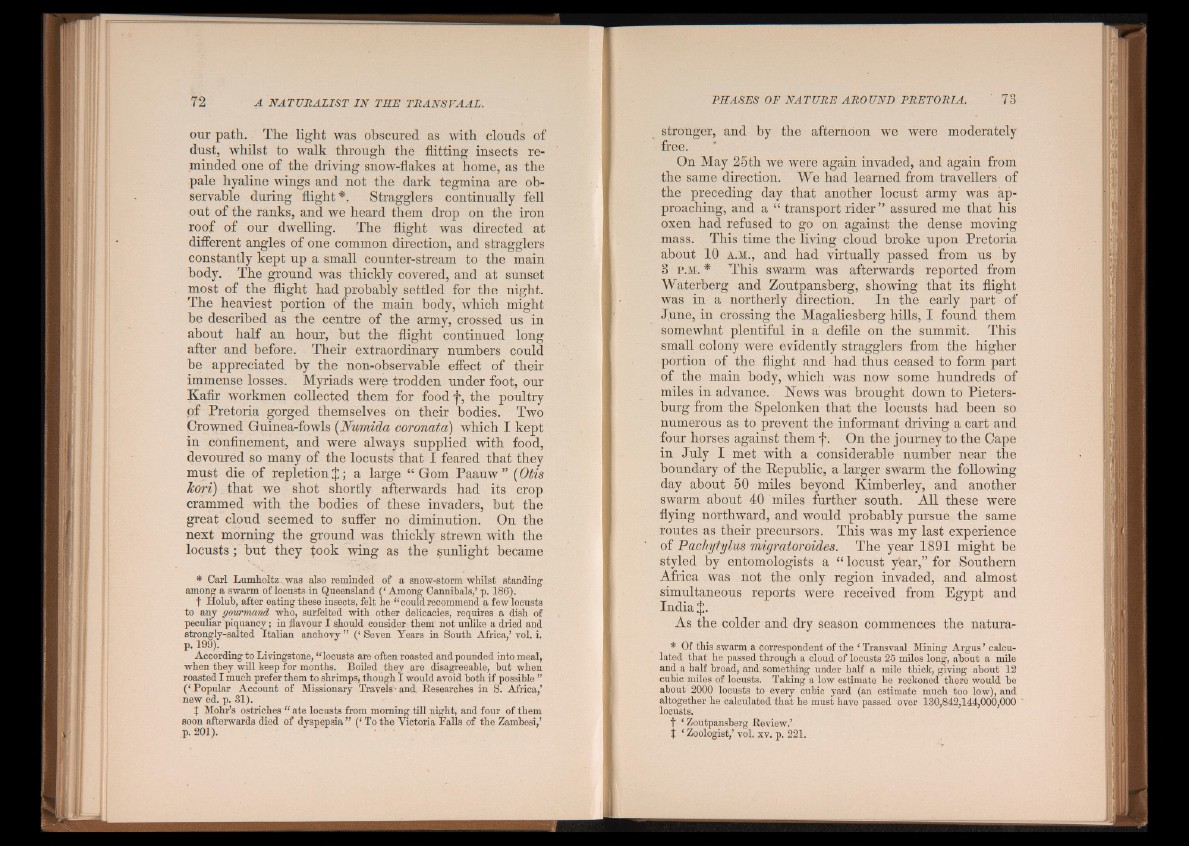
our path. The light was obscured as with clouds of
dust, whilst to walk through the flitting insects reminded
one of the driving snow-flakes at home, as the
pale hyaline wings and not the dark tegmina are observable
during flight*. Stragglers continually fell
out of the ranks, and we heard them drop on the iron
roof of our dwelling. The flight was directed at
different angles of one common direction, and stragglers
constantly kept up a small counter-stream to the main
body. The ground was thickly covered, and at sunset
most of the flight had probably settled for the night.
The heaviest portion of the main body, which might
he described as the centre of the army, crossed us in
about half an hour, but the flight continued long
after and before. Their extraordinary numbers could
he appreciated by the non-observable effect of their
immense losses. Myriads were trodden nnder foot, our
Kafir workmen collected them for food f, the poultry
of Pretoria gorged themselves on their bodies. Two
Crowned Guinea-fowls (Numida coronata) which I kept
in confinement, and were always supplied with food,
devoured so many of the locusts that I feared that they
must die of repletion J ; a large “ Gom Paauw ” (Otis
kori) . that we shot shortly afterwards had its crop
crammed with the bodies of these invaders, but the
great cloud seemed to suffer no diminution. On the
next morning the ground was thickly strewn with the
locusts; but they took wing as the sunlight became
* Carl Lumholtz . was also reminded of a snow-storm whilst standing
among a swarm of locusts in Queensland (‘Among Cannibals,’ p. 186).
f Holub, after eating these insects, felt he “ could recommend a few locusts
to any gourmand who, surfeited with other delicacies, requires a dish of
peculiar piquancy; in flavour I should consider them not unlike a dried and
strongly-salted Italian anchovy ” (‘ Seven Years in South Africa,’ vol. i.
p. 199).
According to Livingstone, “ locusts are often roasted and pounded into meal,
when they will keep for months. Boiled they are disagreeable, but when
roasted I much prefer them to shrimps, though I would avoid both if possible ”
(‘ Popular Account of Missionary Travels • and. Researches in S. Africa,’
new ed. p. 31).
% Mohr’s ostriches “ ate locusts from morning till night, and four of them
soon afterwards died of dyspepsia ” (‘ To the Victoria Palls of the Zambesi,’
p. 201). • ....................
stronger, and by the afternoon we were moderately
free.
On May 25th we were again invaded, and again from
the same direction. We had learned from travellers of
the preceding day that another locust army was approaching,
and a “ transport rider ” assured me that his
oxen had refused to go on against the dense moving
mass. This time the living cloud broke upon Pretoria
about 1 0 a .m., and had virtually passed from us by
3 p .m. * This swarm was afterwards reported from
Waterberg and Zoutpansberg, showing that its flight
was in a northerly direction. In the early part of
June, in crossing the Magaliesberg hills, I found them
somewhat plentiful in a defile on the summit. This
small colony were evidently stragglers from the higher
portion of the flight and had thus ceased to form part
of the main body, which was now some hundreds of
miles in advance. News was brought down to Pieters-
burg from the Spelonken that the locusts had been so
numerous as to prevent the informant driving a cart and
four horses against them f . On the journey to the Cape
in July I met with a considerable number near the
boundary of the Republic, a larger swarm the following
day about 50 miles beyond Kimberley, and another
swarm about 40 miles further south. All these were
flying northward, and would probably pursue the same
routes as their precursors. This was my last experience
of Pachytylus migratoroides. The year 1891 might be
styled by entomologists a “ locust /ear,” for Southern
Africa was not the only region invaded, and almost
simultaneous reports were received from Egypt and
India $.
As the colder and dry season commences the natura-
* Of this swarm a correspondent of the 1 Transvaal Mining Argus ’ calculated
that he passed through a cloud of locusts 25 miles long, about a mile
and a half broad, and something under half a mile thick, giving about 12
cubic miles of locusts. Taking a low estimate he reckoned there would be
about 2000 locusts to every cubic yard (an estimate much too low), and
altogether he calculated that he must have passed over 130,842,144,000,000
locusts.
f 1 Zoutpansberg Review.’
t ‘ Zoologist,’ vol. xv. p. 221.